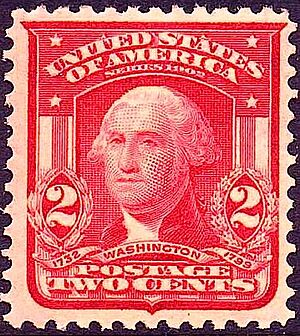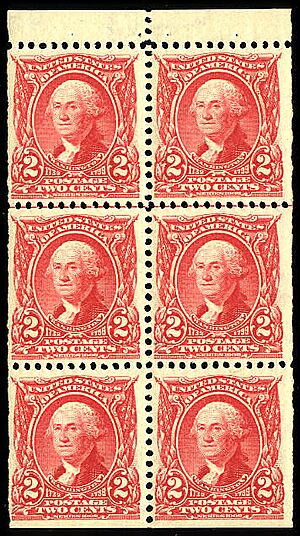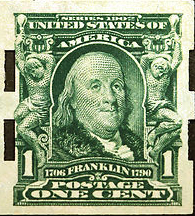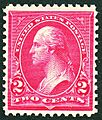Series of 1902 (United States postage stamps) facts for kids
The Series of 1902 is a special collection of postage stamps made by the U.S. Bureau of Engraving and Printing. These stamps were released by the United States Post Office. There were fourteen different stamps in this series, with values from one cent to five dollars. Two stamps came out in late 1902, and the rest were released between January and June 1903.
This series is also called the Second Bureau Issue. It is famous for its very fancy and detailed designs. The stamps were used until late 1908, when newer Washington-Franklin Issues took their place. An extra fifteenth stamp was added in November 1903. This was a new version of the 2-cent stamp, because the first one wasn't very popular.
Contents
How the Stamps Were Designed and Made
Even though it's called the "Second Bureau Issue," this was actually the first time the Bureau of Engraving and Printing designed a full set of regular stamps all by themselves. Before this, in 1894, they just used old designs.
The Post Office was very happy with some earlier special stamps, like the 1901 Pan-American Exposition Issue. They wanted the new regular stamps to be just as beautiful. So, in February 1902, they told the Bureau to make the new series "particularly attractive and distinctive."
Unique Designs for Each Stamp
The result was a set of stamps where each one had its own unique design. This was different from earlier stamps that often used the same basic look for many values. The 1902 stamps were full of artistic details. You can see things like columns, statues, and other architectural features. The letters and numbers also used different styles, making each stamp special.
A cool feature of these designs is how some parts of the pictures stick out into the stamp's edges. You might see an arm, a knee, or even an eagle's beak going past the main picture area.
Meet the Designer: Raymond Ostrander Smith
All fourteen original designs were created by Raymond Ostrander Smith. He was well-known for his work on earlier popular stamp series. For the first time on regular stamps, the birth and death dates of the famous people were printed next to their pictures. Also, "Series 1902" was printed on all the stamps, even if they came out in 1903.
Who Was on the Stamps?
The Series of 1902 featured many well-known Americans. Most of them were the same people who had been on earlier stamps. But there were three new faces!
- Martha Washington was on the 8-cent stamp. This was a big deal because she was the first woman ever to be on a U.S. regular postage stamp!
- Benjamin Harrison, a recently deceased president, was on the 13-cent stamp. This was the first time the U.S. Post Office ever made a 13-cent stamp.
- Admiral David Farragut, a naval hero, was on the $1 stamp.
The 13-cent Benjamin Harrison stamp was the very first one released in this series, on November 18, 1902. The 8-cent Martha Washington stamp followed on December 6.
Stamp Colors and Watermarks
The 1902 stamps also continued using specific colors for different types of mail, as required by the Universal Postal Union.
- 1-cent stamps for postcards were green.
- 2-cent stamps for regular mail were red.
- 5-cent stamps for international mail were blue.
These colors helped postal workers handle mail more easily around the world. Most of the other stamps had colors similar to older issues.
The stamps were printed on special paper with a "U S P S" watermark. This was a security feature to help prevent people from making fake stamps. This watermark was used until 1910.
Hidden Meanings in the Designs
The designs often included symbols that showed what the famous Americans were known for:
- For Benjamin Franklin, there were lightbulbs, representing his work with electricity.
- For Ulysses S. Grant, you could see eagles and flags, showing his military achievements.
- For Abraham Lincoln, there were female figures holding U.S. flags and palm fronds, symbolizing the country coming back together.
- For David Farragut, a marine and a sailor were shown, representing his naval career.
Problems with the 2-Cent Stamp
The Bureau wanted these stamps to be super high quality, but it didn't quite work out. The 2-cent stamp, which was used the most, caused a lot of complaints when it came out in January 1903. People thought the picture of George Washington looked weak and didn't show his heroic image well. Some even joked that he looked like he had a "toper's nose" (a red nose from drinking).
Because of all the complaints, the Post Office decided to replace this "flag" stamp. In November 1903, they released a new 2-cent Washington "shield" stamp, which was much better received.
Challenges with Printing
Another problem was that the detailed designs were larger than usual, leaving little white space around the edges. This made it hard to cut the stamps perfectly straight. Many stamps ended up with parts of the design cut off or looking lopsided. It's quite rare to find a complete set of 1902 stamps that are all perfectly centered!
Special Versions of the Stamps
Stamps in Booklets
In 1900, the Post Office started selling stamps in small booklets. The 2-cent stamps from the Series of 1902 were also sold this way. Booklets with the first 2-cent "flag" stamp came out just a week after the regular sheets. The replacement 2-cent "shield" stamp also came out in booklets a few weeks later.
Later, in 1907, the Post Office also started making 1-cent Franklin stamps available in booklets. Stamps from booklets often have different perforations (the little holes that help you tear stamps apart) on their sides compared to regular sheet stamps.
Imperforate Stamps and Coils
In the early 1900s, new machines were invented to sell and stick stamps. These machines couldn't easily handle the usual perforated stamp sheets. So, vending machine companies asked the Post Office for sheets of stamps that were imperforate (meaning they had no perforations). The companies would then add their own special perforations that worked better with their machines.
The Post Office released imperforate versions of the 1-cent and 2-cent stamps in 1906, and 4-cent and 5-cent stamps in 1908. These were the first imperforate U.S. postage stamps since 1856!
Also in 1908, the Post Office tried selling stamps in rolls (called "coils") for vending machines. The 5-cent stamp came in "vertical coils" (stamps side-by-side, imperforate on the left and right). The 1-cent and 2-cent stamps came in both "vertical coils" and "horizontal coils" (stamps one above the other, imperforate on the top and bottom).
These 1908 coil stamps are very rare and valuable today. Not many were made before the series was replaced. Also, stamp collectors at the time didn't realize how special they were, so many were used and not saved. Some of the rarest coil stamps from this series can be worth hundreds of thousands of dollars!
The 4-cent imperforate stamp is especially rare. No original copies without private perforations exist today. All of them were cut and perforated by a company called Schermack.
The Individual Stamps
- 1¢ Green, Benjamin Franklin
* Issued: February 3, 1903 * Designer: Raymond Ostrander Smith * Special versions: Imperforate (Oct 1906), booklets (Mar 1907), vertical coil (Feb 1908), horizontal coil (Jul 1908).
- 2¢ Carmine, George Washington (Original "flag" version)
* Issued: January 17, 1903 * Designer: Raymond Ostrander Smith * Special versions: Booklets (Jan 1903).
- 2¢ Carmine, George Washington (Second "shield" version)
* Issued: November 12, 1903 * Designer: Clair Aubrey Houston * Special versions: Booklets (Dec 1903), imperforate (Oct 1906), vertical coil (Feb 1908), horizontal coil (Jul 1908).
- 3¢ Purple, Andrew Jackson
* Issued: February 11, 1903 * Designer: Raymond Ostrander Smith
- 4¢ Brown, Ulysses S. Grant
* Issued: February 3, 1903 * Designer: Raymond Ostrander Smith * Special versions: Imperforate (May 1908), all known copies have private perforations.
- 5¢ Blue, Abraham Lincoln
* Issued: January 20, 1903 * Designer: Raymond Ostrander Smith * Special versions: Imperforate (May 1908), vertical coil (Feb 1908).
- 6¢ Brown-red, James Garfield
* Issued: February 20, 1903 * Designer: Raymond Ostrander Smith
- 8¢ Lavender, Martha Washington
* Issued: December 6, 1902 * Designer: Raymond Ostrander Smith * First woman on a U.S. regular stamp!
- 10¢ Pale red-brown, Daniel Webster
* Issued: February 5, 1903 * Designer: Raymond Ostrander Smith
- 13¢ Brownish-purple, Benjamin Harrison
* Issued: November 18, 1902 * Designer: Raymond Ostrander Smith * First 13-cent stamp ever issued by the U.S. Post Office.
- 15¢ Olive-green, Henry Clay
* Issued: May 27, 1903 * Designer: Raymond Ostrander Smith
- 50¢ Orange, Thomas Jefferson
* Issued: March 23, 1903 * Designer: Raymond Ostrander Smith
- $1 Black, Admiral David Farragut
* Issued: June 5, 1903 * Designer: Raymond Ostrander Smith
- $2 Blue, James Madison
* Issued: June 5, 1903 * Designer: Raymond Ostrander Smith * Reprinted in 1917 with different perforations and no watermark.
- $5 Green, John Marshall
* Issued: June 5, 1903 * Designer: Raymond Ostrander Smith * Reprinted in 1917 with different perforations and no watermark.
Images for kids








